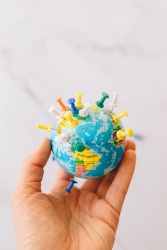Rise in global health financing but funding priorities shift
Rise in global health financing, but funding priorities shift
by Shobha
Shukla
April 9, 2014
A new research done by the Institute for Health Metrics and Evaluation (IHME), at the University of Washington, indicates that globally the total development assistance for health (DAH) hit an all-time high of $31.3 billion in 2013 (a year-over-year increase of 3.9%), although funding priorities shifted. Findings of the research were presented in the report 'Financing Global Health 2013: Transition in an Age of Austerity' by IHME Director and report co-author Dr Christopher Murray and made public at the Centre for Strategic and International Studies on 8th April, 2014.
The report indicates that support for maternal, new born, and child health (MNCH) has increased; public-private partnerships and NGOs are playing a larger role; and government spending on domestic health has risen sharply.
Country wise, India received the maximum DAH of $2.53 billion during 2009-2011; while region wise Sub-Saharan Africa received the largest portion of DAH in 2011 at $8.8 billion, or 28.6% of total DAH.
Disease wise HIV/AIDS, malaria, and TB made up a major portion of global health support in 2011 with HIV/AIDS receiving the maximum funding of $7.7 billion—a 1.2% increase from 2010.
In addition to providing a detailed picture of donors’ global health spending, the report tracks development assistance for different health issues up to 2011. The report shows that pairing DAH with disability-adjusted life years (DALYs) reveals imbalances between disease burden and international investments. There are gaps between donor funding and disease burden in most regions, particularly with respect to non-communicable diseases (NCDs) which form a rising portion of disease burden in the developing world. Although funding for NCDs increased from 2010 to 2011, they were still not a primary focus of DAH, with only $377 million provided in 2011 in the fight against NCDs.
Another disconcerting finding is the low level of funding disbursed for tobacco control in 2011. IHME measured health funding for tobacco control for the first time and found it to be dismally low at just $68 million in 2011—less than 1% of that for HIV/AIDS, even though in 2010, 5.3% of all DALYs in low- and middle-income countries were attributable to tobacco use. There were imbalances between tobacco DAH and DALYs, and tobacco DAH per DALY at the country level remained the lowest among all of the health focus areas highlighted. With the exception of China, India, and Bangladesh, none of the countries with the highest tobacco DALYs received the highest DAH related to tobacco.
On the positive side, the DAH allocated to MNCH increased substantially by 17.7% between 2010 and 2011, reaching $6.1 billion-- reflecting donors’ continued support for the unfinished agenda of MDGs 4 and 5, which aim to reduce child and maternal mortality. Yet, MNCH spending per live birth still remains just $51. According to Dr Murray, “Donors’ continued support for increased spending on maternal, new born, and child health reflects the global sense of urgency to meet the Millennium Development Goals by 2015,”
Dr Christopher Murray told Citizen News Service (CNS) that, “The big difference between development assistance for HIV/AIDS and funding for NCDs from donors has been the results. The scale-up of programmes aimed at preventing mother-to-child transmission of HIV has had an enormous impact, and that has driven more funding. With NCDs, we can see the burden increasing, but it’s much earlier in that process of people demonstrating successful local solutions to decrease that burden. Hopefully those local solutions will come, and, once they do, development assistance for NCDs likely will follow.”
The report also compares development assistance for different health issues to disease burden. Even though sub-Saharan African countries received the greatest volume of malaria assistance, yet as a whole they received less than $60 of malaria funding for every year of healthy life lost to malaria between 2006 and 2010. In comparison, Latin America and the Caribbean received nearly $2,000 of malaria funding per year of healthy life lost during this same period.
As funding from many bilateral donors and development banks has declined, growth in funding from the GAVI Alliance, the Global Fund to Fight AIDS, Tuberculosis and Malaria, non-governmental organizations, and the UK government is counteracting these cuts. Global health funding remains small relative to what high-income countries spend on their own health, representing only 1% of these countries’ health expenditure.
IHME researchers also found that spending by governments of developing countries on health as sourced domestically was $613.5 billion in 2011. Thus government health spending grew at a faster pace (at 7.2%) than assistance from 2010 to 2011and countries on an average spent 20 times more of their own resources on health than they received in assistance. In most countries, donor funding made up less than 10% of total government spending on health. In certain Asian and sub-Saharan African countries, however, DAH accounted for more than 50% of total government health spending.
OTHER MAJOR FINDINGS FROM THE
REPORT ARE:
• The United States continued to be the
single largest channel of DAH, at $7.4 billion in 2013 while
DAH from the UK amounted to $1.2 billion in
2013.
• GAVI’s disbursements reached an estimated
$1.5 billion in 2013, a 32% increase relative to 2012
levels. Funding from the Global Fund to Fight AIDS,
Tuberculosis and Malaria grew 16.8%, to $4 billion, from
2012 to 2013.
• DAH from NGOs increased by 2.4% between
2011 and 2013. Of the NGOs IHME tracked, those based in the
US spent $4 billion while NGOs based outside the US spent
$895 million in 2013.
• Many of the countries with the
highest disease burdens did not receive the most DAH. Of the
countries with the top 20 DALYs, only 13 are among the top
20 recipients of DAH.
• Infectious disease burden
clearly played a role in driving countries to the top of the
DAH recipient list. Nine of the 10 countries on the list
were among the top 20 nations in terms of HIV/AIDS burden.
These nine recipients also received some of the largest
disbursements of DAH for HIV/AIDS. Most countries listed
also ranked high among nations with the greatest malaria
DALYs and DAH.
The report succinctly concludes that, “As the developing world prepares for the post-2015 era, epidemiological, organizational, and economic transitions will continue to catalyze change in DAH disbursements. Improved information, such as the estimates produced by Financing Global Health 2013, will prove vital to development assistance partners as they make decisions about the causes and mechanisms to fund. With timely and comprehensive evidence in hand, stakeholders can work to improve population health in the developing world for generations to come."
Shobha Shukla is the Managing Editor of Citizen News Service - CNS. She is a J2J Fellow of National Press Foundation (NPF) USA and received her editing training in Singapore. She has earlier worked with State Planning Institute, UP and taught physics at India's prestigious Loreto Convent. She also co-authored and edited publications on childhood TB, childhood pneumonia, Hepatitis C Virus and HIV, violence against women and girls, and MDR-TB. www.citizen-news.org


 Martin LeFevre - Meditations: In A Global Society, There Is No Such Thing As “National Security”
Martin LeFevre - Meditations: In A Global Society, There Is No Such Thing As “National Security” Binoy Kampmark: Secrecy And Virtue Signalling - Another View Of Signalgate
Binoy Kampmark: Secrecy And Virtue Signalling - Another View Of Signalgate Gordon Campbell: On The Americanising Of NZ’s Public Health System
Gordon Campbell: On The Americanising Of NZ’s Public Health System Ian Powell: Trumpian Health Leadership
Ian Powell: Trumpian Health Leadership Eugene Doyle: Disruption - Historians Challenge Russophobic Propaganda
Eugene Doyle: Disruption - Historians Challenge Russophobic Propaganda Ramzy Baroud: War, Doublethink, And The Struggle For Survival - Geopolitics Of The Gaza Genocide
Ramzy Baroud: War, Doublethink, And The Struggle For Survival - Geopolitics Of The Gaza Genocide